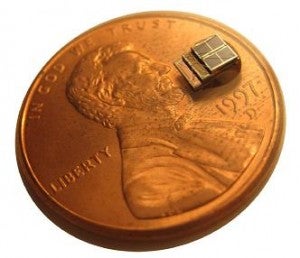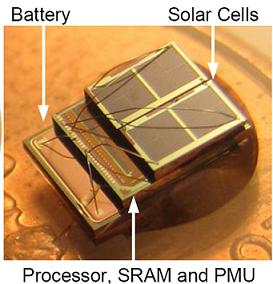Tiny Sensor Could Run For Years Harnessing Energy from Environment

Share
The University of Michigan has produced a miniature sensor that harnesses solar energy and could last for years without needing to be replaced. Composed of a solar cell, processor, and battery, the tiny device is only 2.5x3.5x1mm in size - a thousand times smaller than a commercial version of its type. Presented at the International Solid State Circuit Conference in San Francisco this month, the sensor is making waves for its low power consumption as well as its longevity. If adapted to harness thermal or kinetic energy from its environment, the sensor could be embedded in buildings or bridges for years. This device demonstrates how we will stop monitoring objects from the outside in, and start watching them from the inside out.
While the Michigan sensor is remarkably small, it isn't the most powerful micro system we've seen recently. A nuclear powered MEMS device developed by Cornell will enable cybernetic moth spies to transmit information using RF signals at 5 milliwatts. The Michigan device maxes out near 8 microwatts. Still, Michigan's sensor harnesses ambient energy (solar for now, heat and pressure later) and doesn't rely on a nuclear power source (albeit a very clean and safe one).
Be Part of the Future
Sign up to receive top stories about groundbreaking technologies and visionary thinkers from SingularityHub.


Like many other small electromechanical systems, the Michigan device uses the ARM Cortex M3 processor, a well known 32 bit chip with low power consumption. The real innovation comes in the manner in which the ARM is supplied with power. According to the ISSCC paper, the Michigan team found new ways to control voltages and reduce the energy used by the processor while it is in sleep mode. When the chip is "awake" it actively stores sensor information on temperature and capacitance requiring around 8 microwatts. When the chip is "asleep" it only consumes half a nanowatt - about 2000 times less power than a commercial counterpart. Since the chip only wakes up every few minutes to take readings, the average power consumption less than a nanowatt, which is ridiculously low.
The only real problem I see is that the system has no transmitter. Information is stored in SRAM and presumably stays there until the sensor is retrieved and the data transferred. For many applications, a sensor that could stay active for years and then collected may be a fine solution. However, for continuous monitoring of critical systems you're going to need a transmitter. Of course, that may push the power requirements up from nanowatts to many microwatts.
While most of us probably don't care much about microwatts and nanowatts, it's these improvements in power consumption which will enable some truly remarkable technologies in the future. Embedded sensors in all types of buildings and products may be just around the corner. We could have airplanes with embedded sensors that alert mechanics to long term damages before they became problems. Eventually I think the work done at Michigan will be adapted to enable the use of microscopic robots. As machines become smaller and smarter they will need smaller and smarter ways of acquiring power. Harnessing it from the environment seems like the obvious choice.
[image credits Chen et al, University of Michigan, ISSCC]
Related Articles

How Scientists Are Growing Computers From Human Brain Cells—and Why They Want to Keep Doing It

These Brain Implants Are Smaller Than Cells and Can Be Injected Into Veins

This Wireless Brain Implant Is Smaller Than a Grain of Salt
What we’re reading

